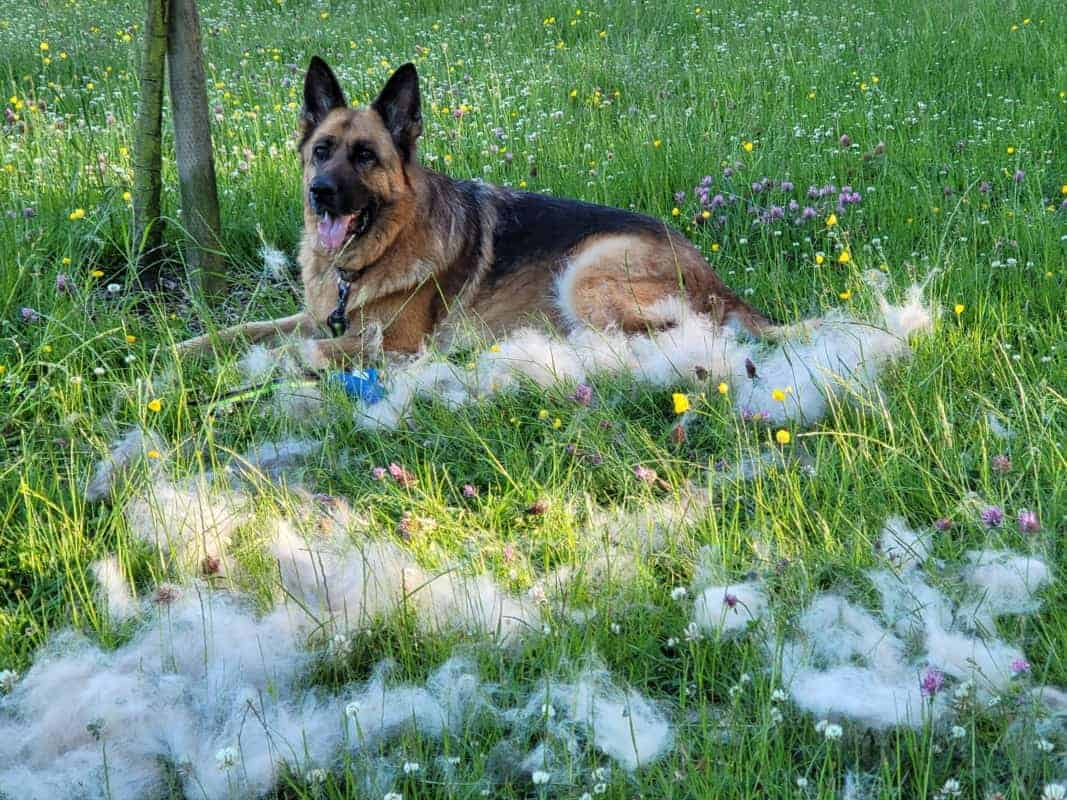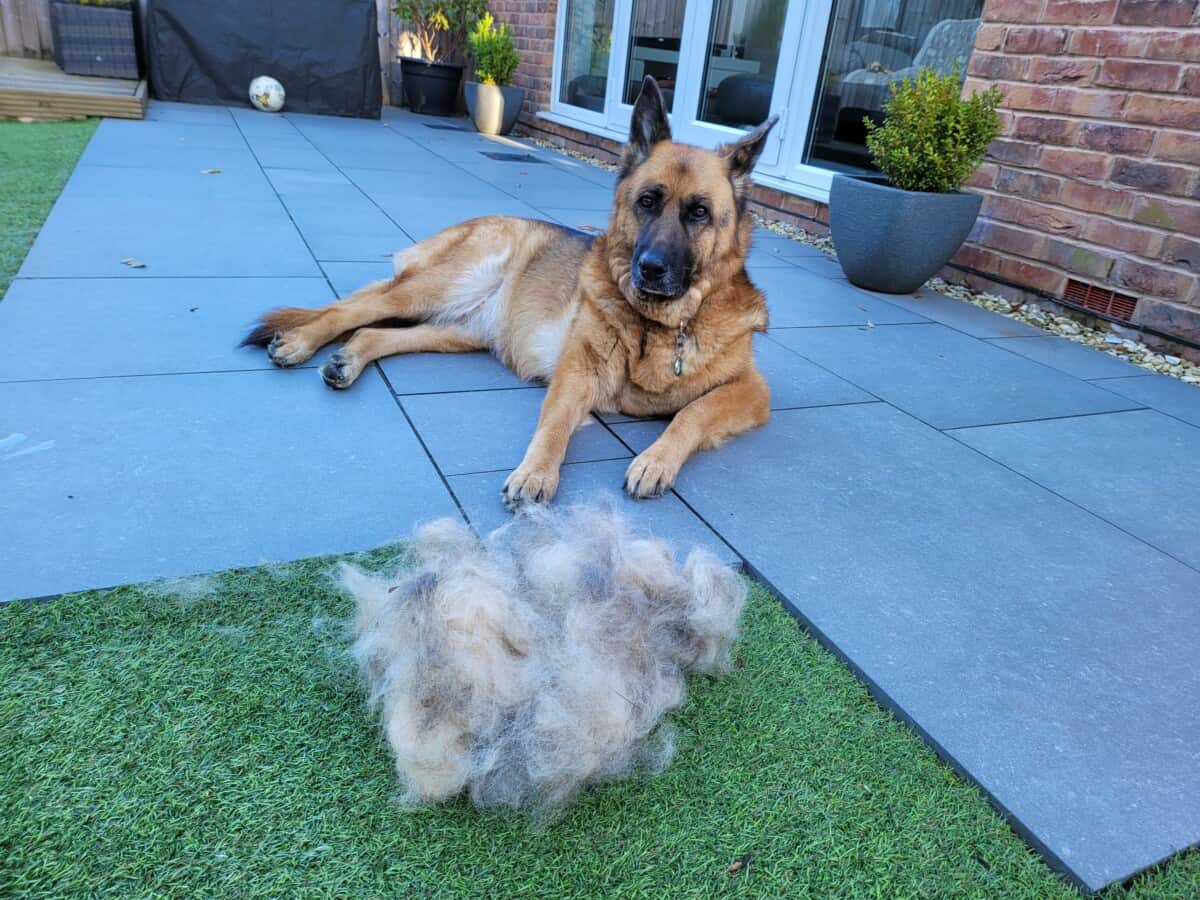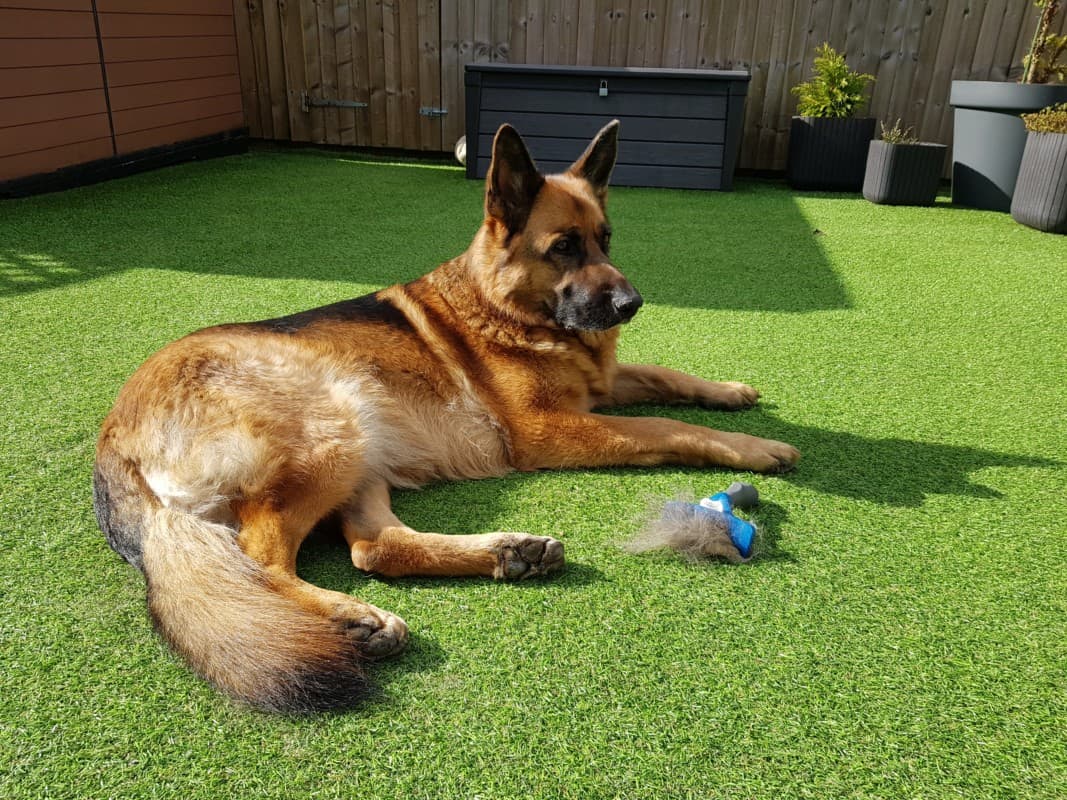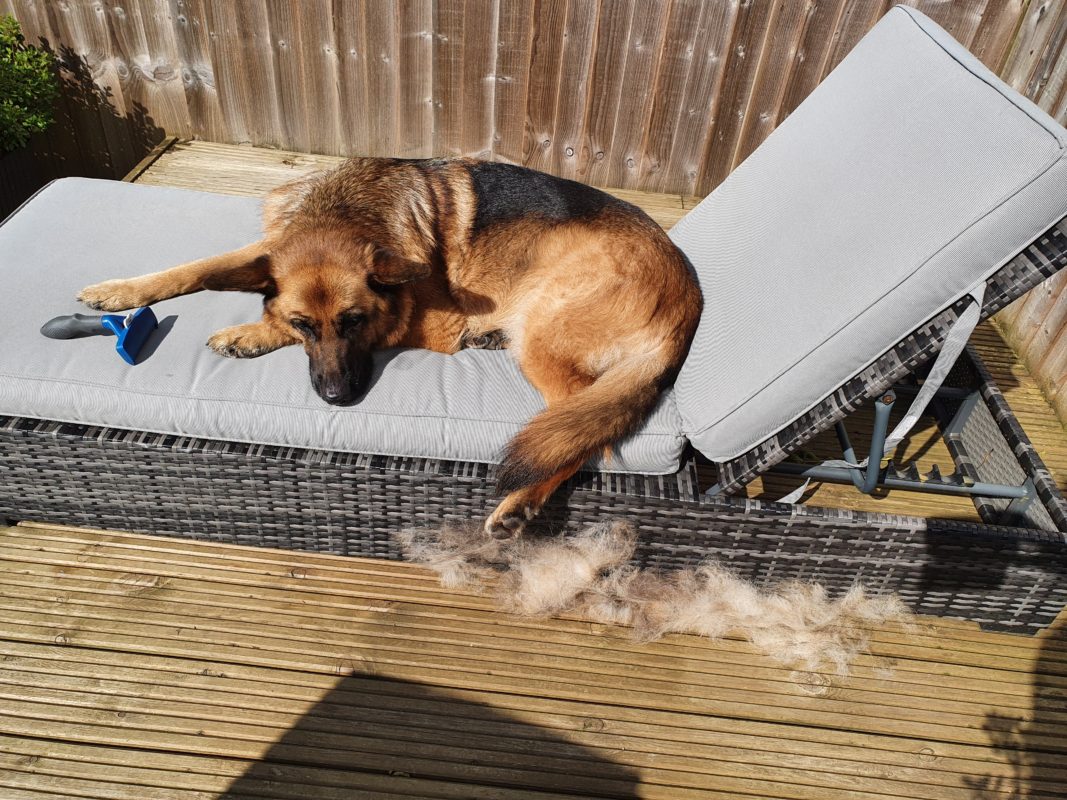If you’re a German Shepherd owner or planning to become one, understanding their shedding habits is crucial. German Shepherds are known for their loyalty, intelligence, and, unfortunately, their prolific shedding.
Don’t worry, though. This guide is your ultimate resource to understand everything about German Shepherd shedding.
- Seasonal Shedding: Learn why your German Shepherd sheds more in certain seasons and how this is linked to their natural coat cycle.
- Managing the Fur: Discover practical tips and tools to effectively manage and reduce the shedding in your home.
- Health and Nutrition: Uncover how diet and overall health can impact your German Shepherd’s shedding patterns.
Whether you’re dealing with your first shedding season or looking for new strategies to manage the fur, this guide offers insights and solutions to help you and your furry friend live comfortably.
Let’s dive into the world of German Shepherds and their fluffy challenges!

Causes of German Shepherd Shedding
German Shepherds are naturally heavy shedders. Short and long-haired varieties will shed consistently all year round, but it gets worse twice annually when they “blow their coat.” This is when clumps of their dense undercoat will fall out in line with temperature and season change.
Let’s look further into the causes of shedding.
Natural Shedding
To fully understand the best methods for controlling and reducing your German Shepherd’s shedding habits, you must first comprehend why he sheds so much. By anticipating the shedding, you will be better prepared to deal with it when it occurs.
German Shepherds shed when their hair goes through its normal growth cycle, and they will lose old or damaged hair. This occurs naturally all year round. Fur is an essential part of GSD’s health because it protects the skin, controls body temperature, and aids sensory perception.
To further understand why German Shepherds shed, we need to look at the coat type.
German Shepherds are double-coated, which means their fur has two layers. They have a thick, soft, woolly undercoat that protects them from cold and heat and aids in temperature regulation.
This is why German Shepherds make excellent outside and working dogs because they can withstand a wide range of weather conditions.
The outer coat, also known as the guard coat, is dense, coarse, slightly wavy, or straight, and its purpose is to protect the dog’s skin and make it resistant to water, dirt, and other external factors.
Unnatural Shedding
However, not all shedding is normal. Some hair loss patterns suggest health problems that, in most cases, should be addressed by a veterinarian.
If you’ve been paying attention to your German Shepherd and have a good understanding of his usual shedding pattern, you’ll know when something is out of the ordinary.
Dog experts can distinguish between shedding, a natural cycle of hair development, and fur loss caused by health, dietary, and environmental factors.
The following symptoms can identify irregular shedding:
- Dry or brittle fur
- Skin allergies and irritation
- Open sores, blisters, and bald patches
- Dislike of petting
So, what’s the deal with these anomalies? A variety of factors can cause atypical fur loss in German Shepherds. Let’s take a look at these:
- Poor diet. A healthy, balanced diet provides a consistent supply of essential nutrients. Your German Shepherd’s hair needs this nutrient supply to stay firmly in the hair follicles. As such, a poor diet lacking nutrients will cause hair loss.
- Dehydration. When your dog loses more water than he is taking in, it compromises healthy blood flow and oxygen delivery to tissues and organs, including the skin. The resulting loss of skin elasticity makes the fur easily fall out. Consider getting a dog water fountain, such as the Petsafe Drinkwell from Amazon, that encourages your dog to drink. I particularly like this one as it has two tiers and includes carbon filters to remove bad taste and odors from the water.
- Parasites, ticks, lice, and fleas. These all cause your dog’s skin to itch, and as a reaction, your dog bites or scratches. This breaks the pet’s hair, and the chewed skin can become infected.
- Cushing’s disease. A benign tumor causes this in the pituitary, which prompts excessive production of the stress hormone cortisol, which causes hair loss in dogs. 100,000 dogs are diagnosed with Cushing’s disease each year, with dogs older than six years being at greater risk.
- Hypothyroidism. Some symptoms of hypothyroidism include increased shedding, hair loss, and thinning. However, it’s not a widespread disorder in dogs, and German Shepherds are not among the three most susceptible breeds.
- Underdeveloped hair follicles. This can be congenital, even though not necessarily hereditary. The hair follicles fail to develop as they should, causing patchy or general hair loss.
- Behavioral problems. High levels of stress and anxiety, such as separation anxiety or OCD, can cause your German Shepherd to chew its hair and skin, leaving patches. This condition is known as acral lick dermatitis. Parasites and other allergic conditions can also cause it.
- Skin trauma. Skin trauma such as bacterial and fungal infections, food and other allergies, some pet medications like steroids, inflammatory disease, and burns can cause excessive shedding. Temporary fur loss can also happen during pregnancy, lactation, or convalescing.
Note: Clicking the above link(s) will take you to Amazon or an online store where we have an affiliate relationship. If you make a purchase, we may earn a commission at no additional cost to you.
Whatever the cause of abnormal hair loss is, your vet must diagnose it accurately. Nonetheless, remedies and preventive measures for unnatural hair loss are similar to controlling excessive seasonal shedding. Read about these measures later in the article.
Learn More About Reducing Shedding in Your Dog…
Shedding Season
The massive seasonal shedding occurring in German Shepherds at certain times of the year, also known as “blowing the coat,” may seem unusual.
If you weren’t aware of this extra shedding, you might wonder why you have so much fur floating around. Welcome to the German Shepherd shedding season!
German Shepherds shed the most in the fall and spring. They shed most of their undercoat during September, October, and November and replace it with a thicker, warmer winter coat. They will then shed their old winter undercoat during March, April, and May, making room for a lighter summer coat.
From a seasonal shedding perspective, due to temperature changes, it’s normal for the German Shepherd to “blow” most of their thinner, soft, woolly undercoat in the fall months to make way for a woolier winter coat. This prepares them for the cold winter months ahead.
Spring shedding is also within the norm among German Shepherds. This time, the breed sheds most of its thick undercoat to allow a lighter, thinner version to better cope with the summer heat. The outer guard hairs also give protection against the sun by reflecting the sun’s rays.

How To Reduce Shedding
Having established that the German Shepherd sheds all year round and undergoes excessive shedding in the fall and spring, you may wonder how to get your German Shepherd to stop shedding…
To get your German Shepherd to stop shedding, brush him daily, use an undercoat de-shedding tool in shedding season, twice per week, bathe him 3-4 times a year, switch to a healthy diet that promotes a healthy coat and skin, keep him hydrated, and keep parasites at bay.
Unfortunately, you will never be able to stop shedding completely – as that’s going against nature! So when I use the phrase “stop shedding,” I suppose what I really mean is control and reduce shedding.
Nonetheless, the measures below will give your German Shepherd’s skin solace, maintain a vibrant coat, and save your couch, floor, and clothes from excess hair!
1. Good Hair Grooming
Good fur grooming is your best bet for coping with excessive shedding in your German Shepherd. However, depending on your dog’s coat type determines how to do it.
German Shepherds are categorized according to their outer coat as medium-length (normal) or long-haired. Whereas some kennel clubs will register both varieties, others, like the AKC, only register the medium-length GSD.
This variation in hair length also means a difference in hair grooming, especially when brushing and de-matting.
I recommend a de-matting tool to remove mats or tangles for longer-haired German Shepherds. Ideally, choose an adjustable tool to work on all coat lengths for the safe removal of matted fur.
Three key aspects of hair grooming during the heavy shedding seasons for both varieties are important: hair brushing, de-shedding, and regular bathing.
Hair Brushing and Deshedding
Usually, two or three times a week is enough to brush your German Shepherd. However, when your dog is “blowing” his coat, you should brush daily. It helps remove the dead hair and stimulate your GSD’s hair follicles, allowing for natural hair growth and a healthy coat.
For a thorough brushing, brush in the direction the coat grows to eradicate loose dead hair. Most dogs don’t like to be brushed against the direction of their fur.
You should de-shed your German Shepherd 2-3 times weekly to help remove the undercoat before it falls away, leaving clumps scattered all over your home!
Two key hair grooming tools will be necessary for both brushing and de-shedding: a slicker brush to detangle any knots or mats and a de-shedding undercoat brush to rid your Shepherd’s coat of loose hair and undercoat.
Here’s a quick review of both of these grooming tools:
This slicker brush is perfect for a double coat breed like the German Shepherd since it untangles mats and knots and penetrates the undercoat to remove loose fur without hurting your dog’s skin. It’s a must-have tool for the rarer long-haired German Shepherd.
The brush has a non-slip handle and a self-clean button that retracts the bristles, so the removed fur easily falls off, and your brush is ready for the next grooming session.
This de-shedding tool is specifically designed for large, heavy shedders like the German Shepherd, and it’s the one that I use.
It will safely eliminate loose fur during the heavy shedding season without ruining the overcoat or your German Shepherd’s skin. I have tried other expensive tools, but I like this the best as it’s easy to use and really does the job.
The tool has an ejector button to release the fur magically, and the handle is ergonomic for easy grooming and comfortable handling. You can choose either a long hair tool or a short hair one.

Like me, if you like the FURminator brand, they also have a grooming rake ideal for thick fur and dense double coats.
You can check out my favorite three Furminator grooming tools here.
Regular Baths With Dog Shampoo
An occasional bath is good enough for the German Shepherd as they are naturally clean and tend to be odor-free.
However, I suggest a couple of extra baths in the heavy shedding season to help reduce hair loss, as bathing your dog rids the coat of dead hair.
You should consult your German Shepherd’s veterinarian for specific instructions on how much you should bathe your dog during the shedding season.
The most important thing to note is that too many baths will deplete your GSD’s natural oil and impair its insulation function. Three or four times a year is a general opinion.
You can check out this article for more info: 5 Defining Moments When to Bathe a German Shepherd.
Always use dog shampoo when bathing. I recommend a naturally derived formula with a conditioner like the TropiClean 2-in-1 Shampoo & Conditioner. Unlike synthetic products, this shampoo is gentle on your dog’s skin and is safe even for dogs with sensitive skin.

2. Feed High-Quality Food
Your German Shepherd naturally molts plenty in shedding season. But if your dog is not fed a healthy diet, the shedding will be worse. To keep shedding in the normal, always feed your GSD with high-quality food.
This implies the right amounts of protein, fats, carbohydrates and fiber, vitamins, minerals, and, of course, water.
Healthy, nutritious dog food contains meat, grains, vegetables, and fruits. These are not just nourishing, but they are also appropriate for your dog’s digestive system.
You can also check out my article on the best diet for German Shepherds, which has loads more info on nutrition, types of diet, and exactly what your GSD can and can’t eat.
A healthy diet for your German Shepherd also means avoiding foods that may cause allergies or intolerances, such as those containing soy, gluten, additives, or preservatives. Food allergies are among the main causes of poor skin health and hair loss.
3. Control Parasites (Ticks, Lice, Fleas)
Ticks, lice, and fleas on your dog’s coat will cause itching and scratching, resulting in even more shedding. Your German Shepherd needs to take regular flea treatment prevention. My GSD takes her treatment every three months.
Many anti-flea/tick/lice products are on the market, including shampoos such as TropiClean Natural Flea & Tick Dog Shampoo. It kills ticks, fleas, and mosquitoes while soothing the skin. It’s a sensitive formula with lanolin, oatmeal, a coconut extract, and soothing aloe.
4. Behavior Modification Techniques
Sometimes, German Shepherds can excessively itch their bodies and experience significant shedding.
While there can be environmental and physical reasons associated with this behavior, certain scenarios would demand behavior modification and proper training to accomplish the same.
If you’re looking to do your part in modifying the behavior and training your German Shepherd to control the shedding behavior, here are a few tips:
- Reduce stress: Stress can cause excessive shedding in dogs, so reducing your German Shepherd’s stress levels can help control shedding. You can do this by providing a calm and predictable environment, avoiding loud noises or sudden movements, and giving your dog plenty of attention and affection.
- Teach good behavior: As mentioned earlier, teaching your German Shepherd good behavior can help reduce shedding. For example, if your dog jumps on furniture or people, they are more likely to leave hair behind. Teaching your dog to stay off the furniture and not to jump on people can help reduce the amount of hair they leave behind.
- Address anxiety: Anxiety can also cause excessive shedding in dogs. If your German Shepherd is anxious, you can address this through behavior modification techniques such as desensitization and counter-conditioning. This involves gradually exposing your dog to the things that make them anxious in a controlled and positive way and rewarding them for calm behavior.
- Regular exercise: Regular exercise is important for reducing stress and anxiety in dogs, which can, in turn, reduce shedding. Take your German Shepherd for daily walks or runs, and ensure they have plenty of opportunities to play and explore.
- Manage allergies: If your German Shepherd has allergies, this can cause excessive shedding. Behavior modification techniques such as avoiding allergens and using medication to manage symptoms can help reduce shedding in these cases.
5. Other Measures
Apart from the three solutions discussed, there are a couple of others that you could consider:
- Talk to your vet about supplementing your German Shepherd’s diet. If you suspect he has any nutritional deficiencies due to health or other reasons, get your vet to check him over.
- Add flaxseed or olive oil to your dog’s food to provide omega-3 fatty acids. These are crucial for a healthy, shiny coat and for controlling skin inflammation. Alternatively, include dog-safe fish types, such as salmon, in your GSD’s diet.
- Use supplements containing Omega 3. Many owners prefer supplements such as Zesty Paws Omega 3 Alaskan Fish Oil Chews. These get thousands of positive reviews and come in bacon or chicken flavors, but check with your vet first.
Does Shaving a German Shepherd Help With Shedding?
Now that you know how to control and reduce your German Shepherd’s shedding, I’ll tell you one important thing you should not do. Shaving!
Shaving a German Shepherd does not help with shedding. You should never shave your German Shepherd’s fur as it will irritate, leading to constant scratching and extra shedding. It will also expose your dog to extreme cold in winter and heat in summer.
Unless there are valid health reasons, you should not shave your German Shepherd’s hair.
Key Takeaways
Here are the key takeaways from the article.
- Excessive shedding is a normal daily occurrence.
- GSDs shed even more in the spring and fall when they “blow” their coat.
- A poor diet, certain health conditions, or the infestation of fleas and other parasites can cause unnatural shedding.
To control and reduce your German Shepherd’s daily and seasonal shedding, ensure proper grooming with the right tools, feed your dog with a healthy, high-quality diet, and prevent and kill fleas.





